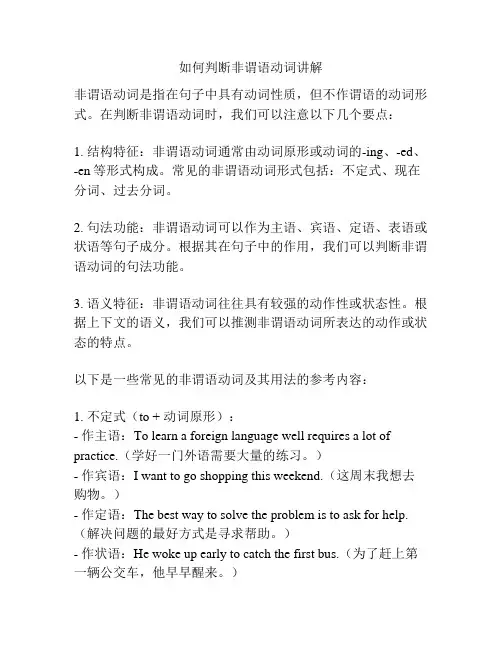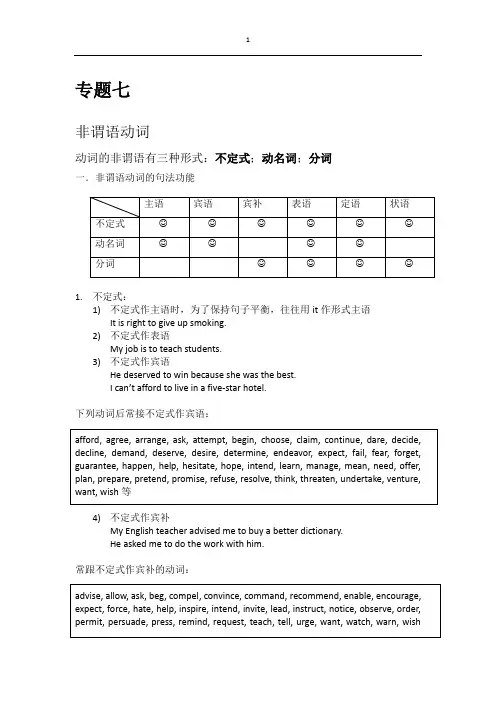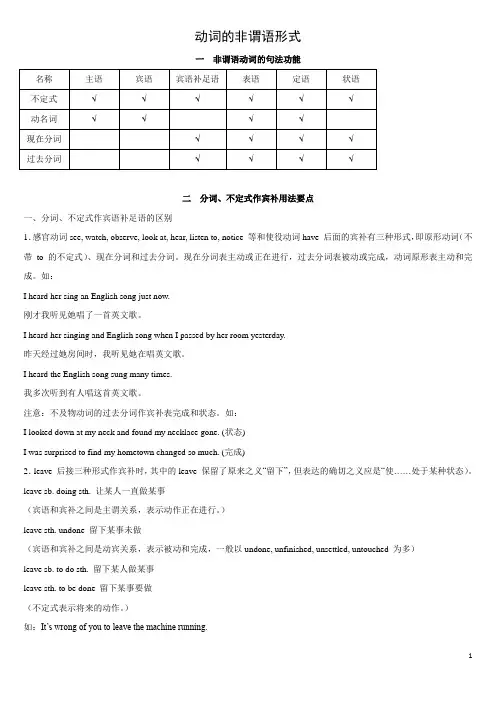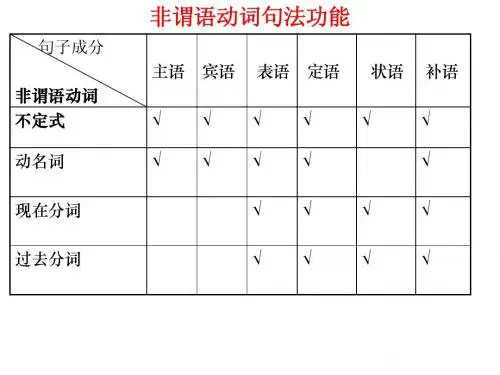非谓语动词间句法功能..
- 格式:ppt
- 大小:1.28 MB
- 文档页数:31



如何判断非谓语动词讲解非谓语动词是指在句子中具有动词性质,但不作谓语的动词形式。
在判断非谓语动词时,我们可以注意以下几个要点:1. 结构特征:非谓语动词通常由动词原形或动词的-ing、-ed、-en等形式构成。
常见的非谓语动词形式包括:不定式、现在分词、过去分词。
2. 句法功能:非谓语动词可以作为主语、宾语、定语、表语或状语等句子成分。
根据其在句子中的作用,我们可以判断非谓语动词的句法功能。
3. 语义特征:非谓语动词往往具有较强的动作性或状态性。
根据上下文的语义,我们可以推测非谓语动词所表达的动作或状态的特点。
以下是一些常见的非谓语动词及其用法的参考内容:1. 不定式(to + 动词原形):- 作主语:To learn a foreign language well requires a lot of practice.(学好一门外语需要大量的练习。
)- 作宾语:I want to go shopping this weekend.(这周末我想去购物。
)- 作定语:The best way to solve the problem is to ask for help.(解决问题的最好方式是寻求帮助。
)- 作状语:He woke up early to catch the first bus.(为了赶上第一辆公交车,他早早醒来。
)2. 现在分词(动词-ing形式):- 作主语:Painting is my favorite hobby.(绘画是我最喜欢的爱好。
)- 作宾语:I enjoy reading books in my free time.(我喜欢在闲暇时间读书。
)- 作定语:The running water is very clear.(流动的水非常清澈。
)- 作状语:Smiling, she accepted the award.(她微笑着接受了奖励。
)3. 过去分词(动词-ed或-en形式):- 作主语:Broken glass should be handled with care.(破碎的玻璃应小心处理。

非谓语动词的句法功能及比较一、作主语(现在分词和过去分词不能作主语)1.不定式与动名词作主语,在表示抽象概念时两者往往可以互换。
To study hard (Studying hard) is our task.It is not easy to master English.It is not easy to mastering English.◆表示比较具体的动作或某一特定的动作或将来的动作多用不定式。
It is necessary to read it many times.To finish the task within two weeks is very difficult.◆主语是不定式,表语一般也要用不定式,动名词的情况也是如此。
To see is to believe. Seeing is believing.2.在下列结构中常用动名词(往往表示比较抽象的动作)It is no use doing sth.It is no good doing sth.It is (a) waste of time/money doing sth.There + be + no + doinghave trouble/problem/difficulty (in) doingspend time/money (in) doinghave a good/hard time in doing sth.have fun in doing sth.There is no joking about such matters.There is no denying the fact that the new method is much better.二、作宾语(现在分词和过去分词不能作宾语)1.英语中有个别动词后面带不定式和动名词作宾语意义上无很大的区别。
这样的动词有:like, love, prefer, start, begin, continue, hate, intend (+ to do或doing)等。


专题七非谓语动词动词的非谓语有三种形式:不定式;动名词;分词一.非谓语动词的句法功能1.不定式:1)不定式作主语时,为了保持句子平衡,往往用it作形式主语It is right to give up smoking.2)不定式作表语My job is to teach students.3)不定式作宾语He deserved to win because she was the best.I can’t afford to live in a five-star hotel.下列动词后常接不定式作宾语:afford, agree, arrange, ask, attempt, begin, choose, claim, continue, dare, decide, decline, demand, deserve, desire, determine, endeavor, expect, fail, fear, forget, guarantee, happen, help, hesitate, hope, intend, learn, manage, mean, need, offer, plan, prepare, pretend, promise, refuse, resolve, think, threaten, undertake, venture, want, wish等4)不定式作宾补My English teacher advised me to buy a better dictionary.He asked me to do the work with him.常跟不定式作宾补的动词:advise, allow, ask, beg, compel, convince, command, recommend, enable, encourage, expect, force, hate, help, inspire, intend, invite, lead, instruct, notice, observe, order, permit, persuade, press, remind, request, teach, tell, urge, want, watch, warn, wish等*注意:(1)下列动词在主动语态中用不带to的不定式作宾补(但在被动语态中要还原to): “五看三使两听一感觉“五看(look at, see, watch, notice, observe)三使(make, let, have)两听(hear, listen to)一感觉(feel)例:I often hear him sing the song.He is often heard to sing the song.(2)在下列结构的than之后常接不带to的不定式:(would rather…than; rather than; do more than; do less than)例:I would rather go than stay.5)Hope, demand, suggest等后不能接动词不定式作宾补I hope/demand/suggest you to come. (错)I hope that you can come. (正确)6)不定式作定语a)不定式作定语大都用于表示即将发生的动作He’s finally made a decision to leave.The farmers thought of ways to protect their corps.b)作定语的不定式如果是不及物动词,或者不定式所修饰的名词或代词是不定式的地点、工具等,不定式后面要有相应的介词The Jacks have a comfortable house to live in.(如果不定式修饰的名词是time, place, way时,不定式后面的介词习惯上省去)He had no money and no place to live (in).c)用来修饰被序数词、最高级或no, all, any等限定的中心词,且与中心词为主动关系Jack is the best man to do this job.Liuxiang was the first Asian athlete to win the gold medal of man’s 110mhurdle race in the Olympic Games.d)被修饰词是抽象名词时用不定式:ability, chance, idea, fact, excuse,promise, answer, belief, attempt, way, reason, moment, time等Do you have the ability to read this English novel?I got no chance to go fishing.7)不定式作状语a)作目的状语I came here to see you.Jack had to shout to make himself heard above the sound of music.*注:(不定式本身有自己的主语时,可用“for…to”来表示)My father bought a book for me to read.目的状语还可以用以下方法表达:(in order to 可置于句首表示强调;so as to 通常不至于句首)b)作结果状语He hurried to the school to find nobody there.(表达令人意外的结果用only +to find/realize)He lifted a rock only to drop it on his own feet.c)作条件状语To look at him, you would like him.(某些形容词作表语,表示喜、怒、哀、乐,后跟不定式表示原因)I’m very glad to see you.I should be happy to be of any service to you.d)作原因状语We were very excited to hear the news.e)带有enough或too的句子里,也常用不定式作状语,表示程度He was too excited not to say a word.He is old enough to go to school.8)不定式作独立成分常用的短语有:to be frank坦白地说;to be exact确切的说;To make a long story short 长话短说; needless to say 不用说9)不定时的时态(一)不定式的一般式(to do; to be done)1.表示与谓语动词同时(或几乎同时发生)I saw him go out.2.表示在谓语动词之后发生I plan to attend the meeting tomorrow.(二)不定式进行时(to be doing)1.表示谓语动词的动作发生时,不定式的动作正在进行He pretended to be sleeping when I came in.2.表示在谓语动词之后发生He is believed to be coming.(三)不定式完成时(to have done; to have been done)1.如果不定式的动作发生在谓语动词之前,就要用完成时The novel is believed to have been translated into Chinese.I’m sorry to have kept you waiting.(不定式的完成时常用在appear, believe, hope, pretend, seem等表示看法与想法的动词后)2.如果不定式由持续动词构成,而且句中有for, since等表示段时间的时间状语,则不定式的完成时表示持续到谓语动词之时仍没有结束He seems to have been ill for a long time. (强调现在还病着)I’m happy to have lived with you since I came to this school. (强调现在仍住在一起)3.不定式的完成时表示没有实现的愿望I hoped to have finished the work earlier. (我本希望能够尽早完成工作)I intend to have come to see you. (我本打算来看你)2.动名词:1)作主语Seeing is believing. 眼见为实2)作表语My job is teaching.3)作宾语He finished reading the book yesterday.i.下列动词只能接动名词作宾语:consider, suggest/advise, look forward to, excuse, admit, delay/put off, fancy, avoid, miss, keep/keep on, practice, deny, finish, enjoy/appreciate, forbid, imagine, risk, can’t help, mind, allow/permit, escapeii.动词词组正能接动名词作宾语:Be used to, devote to, lead to, stick to, get down to, pay attention to, can’t stand, give up, feel like, insist on, thank you for, apologize for, be busy in, have difficulty/trouble in, have a good time in, spend time in等iii.动词need, require, want作“需要”讲时,deserve作“应得”讲时,其后跟动词作它的宾语表示主语是该动作的承受者时,必须用动名词主动式(或不定式的被动式)表示被动意义The window needs/requires/wants cleaning/to be cleaned.He deserved hanging/ to be hanged. (他罪当被绞死)iv.在excuse, forgive, pardon后接动名词时通常需要再动名词之前加上形容词性物主代词,也可接宾格人称代词+for+-ingExcuse me for opening your letter.=Excuse my opening your letter.Forgive me for interrupting you.=forgive my interrupting you.4)动名词的时态(一)一般式(v-ing; being done)如果动名词的动作没有明确地表示出时间是与谓语动作同时发生还是在谓语动作之前发生,用一般式We are interested in playing cards.His coming will be of great help to us.(二)完成式(having done; having been done)动名词的动作发生在谓语动词所发生的动作之前,通常用动名词完成式I’m sorry for not having kept my promise.*注:动名词语态(在to be worth doing 句型中,动名词doing表示的是被动,修饰worth用well)例:The book is well worth reading.5)动名词和不定式结构在意义上的区别:动名词表示一般习惯,抽象概念,用于描述发生在主要动词之前的行为不定式表示具体的或特定的动作,用于描述发生在主要动词之后的行为Playing with fire is dangerous. (泛指玩火)To play with fire is dangerous. (指这一具体动作)下列动词或词组既可以跟动名词作宾语,也可以跟不定式作宾语,但在意义上有所差别:1.forget to do sth. 忘记做某事;forget doing sth. 忘记已经做过某事2.remember to do sth. 记得要做某事;remember doing sth. 记得曾经做过某事3.stop to do sth. 定下来去做里一件事;stop doing sth. 停止做某事4.try to do sth. 努力做某事;try doing sht. 尝试着做某事5.go on to do sth. 接着做另一件事情;go on doing sth. 接着做同一件事情6.can’t help to do sth. 不能帮助做某事;can’t help doing sht. 情不自禁做某事3.分词1)做表语:(表示主语的性质或特征)He was very amusing.That book was rather boring.2)作宾补:现在分词在一些动词之后可以做宾语的补语,例如:see, hear,catch, find, keep , have 等.I see him passing my house every day.I caught him stealing things in that shop.We found her greatly changed.3)作定语(一)单个分词作定语时,通常放在被修饰词之前;副词短语作定语时,通常放在被修饰词之后The man standing at the window is our teacher.Polluted air and water are harmful to pelple’s health.Most of people questioned refused to answer.(二)现在分词作定语,表示动作正在进行或与动词所表示的动作几乎同时发生,或表示某个经常性的动作或状态The gentleman standing there is my teacher.(三)现在分词的被动式作定语强调动作正在进行中The house being built will be our office building.Did you see the boy being questioned by the police?(四)分词完成式不能做定语。

动词的非谓语形式一非谓语动词的句法功能二分词、不定式作宾补用法要点一、分词、不定式作宾语补足语的区别1.感官动词see, watch, observe, look at, hear, listen to, notice 等和使役动词have 后面的宾补有三种形式,即原形动词(不带to 的不定式)、现在分词和过去分词。
现在分词表主动或正在进行,过去分词表被动或完成,动词原形表主动和完成。
如:I heard her sing an English song just now.刚才我听见她唱了一首英文歌。
I heard her singing and English song when I passed by her room yesterday.昨天经过她房间时,我听见她在唱英文歌。
I heard the English song sung many times.我多次听到有人唱这首英文歌。
注意:不及物动词的过去分词作宾补表完成和状态。
如:I looked down at my neck and found my necklace gone. (状态)I was surprised to find my hometown changed so much. (完成)2.leave 后接三种形式作宾补时,其中的leave 保留了原来之义―留下‖,但表达的确切之义应是―使……处于某种状态)。
leave sb. doing sth. 让某人一直做某事(宾语和宾补之间是主谓关系,表示动作正在进行。
)leave sth. undone 留下某事未做(宾语和宾补之间是动宾关系,表示被动和完成,一般以undone, unfinished, unsettled, untouched 为多)leave sb. to do sth. 留下某人做某事leave sth. to be done 留下某事要做(不定式表示将来的动作。

在句子中充当除谓语以外的各种句子成分的动词形式叫做非谓语动词(the Non-Finite Verbs)。
非谓语动词有三种:不定式(the Infinites)、动名词(the Gerunds)和分词(the Participles)。
动词不定式的时态、语态动词不定式可以作以上各种成分,但它毕竟是动词,所以有动词的属性动词不定式及其短语还可以有自己的宾语、状语,虽然动词不定式在语法上没有表面上的直接主语,但它表达的意义是动作,这一动作一定由使动者发出。
这一使动者我们称之为逻辑主语,其形式如下:主动形式被动形式一般式(not)to make (not)to be made完成式(not)to have made (not)to have been made进行式(not)to be making完成进行式(not)to have been making(1)语态如果动词不定式的逻辑主语是这个不定式所表示的动作的承受者,不定式一般要用被动语态形式。
如:It's a great honour to be invited to Mary's birthday party.(不定式作主语)It was impossible for lost time to be made up.(不定式作主语)I wish to be sent to work in the country.(不定式作宾语)Can you tell me which is the car to be repaired?(不定式作定语)He went to the hospital to be examined.(不定式作状语)在There be结构中,修饰主语的不定式可用被动,也可用主动。
如:There are still many things to take care of (to be taken care of).但有时两种形式表达的意思不同,如:These is nothing to do now.( We have nothing to do now.) There is nothing to be done now.(We can donothing now.)(2)时态1) 现在时:一般现在时表示的动词,有时与谓语动词表示的动作同时发生,有时发生在谓语动词的动作之后。


高考英语非谓语动词的基本形式及基本功能名称形式特点功能不定式To do具有名词、形容词、副词、动词的一些特征在句中可做主语、宾语、表语、定语、状语、补足语,有形式变化动名词Doing(v+ing)具有名词、形容词、动词的一些特征在句中可做主语、宾语、表语、定语,有形式变化分词Doing(v+ing)Done(v+ed具有形容词、副词的一些特征在句中可做表语、定语、状语、补足语,现在分词有形式变化不定式I.不定式的时态及语态一般式 to do to be done 与谓语动作同时或进行式 to be doing 表示谓语的动作发生时,不定式的动作正在进行完成式 to have done to have been done 先于谓语动作的发生II. 不定式的否定结构:not to do//for sb not to doIII.不定式的句法功能1.主语To see is to believe.It is not easy to learn a language well.(不定式作主语时往往用it做形式主语) 动词不定式做主语的常用句型It is +adj/n +to do sthIt is +adj +of/for sb to do sthIt takes sb sometime to doKind, clever, wise, nice 形容词既表示人物特征,Foolish, stupid, honest, 又表示说话人对不定式Right, correct, wrong, +of sb 动作的评价;形容词与Rude, cruel, careless, 介词宾语成主谓关系Lazy, selfish, horrible如:It's kind of you to help me。
=You are kind to help me。
Easy, hard, difficultPossible, necessary, 形容词说明不定式行为的Important, essential, +for sb 性质,与介词宾语不具有Interesting, unusual,………..主谓关系Interesting, natural如: It's easy for me to learn English.=To learn English is easy for me.2..表语My job is to attend the children.(不定式作表语时,如在它前出现了do, did, does时,不定式符号to 可省掉,例: what you have to do this afternoon is (to) look after the sick child.)3.定语I have a lot of work to do. //She has no place to go.4.宾语I hope to go to Dalian again.I find it interesting to play the violin.(不定式作宾语时,如果还带有宾语补足语,往往用it作形式宾语,而把真正的宾语放到后面)5.宾补The teacher told us to clean the windows.I noticed the boy go into the shop.注: feel, listen to, hear, see, watch, notice, observe, look at, make, let ,have等使役动词后宾语补足语时,不定式符号to要省略,但这些句子变为被动语态时,就必须带to 符号. 例:I often hear him sing this song.He is often heard to sing this song.6.状语表示目的: I got up early to(in order to/ so as to) catch the early bus.To/In order to pass the exam, he worked hard.(so as to不能用于句首) 表示原因: We were excited to hear the news.I am sorry to have hurt you.表示结果: I hurried home to find Mary waiting for me.(不定式作结果状语时,常表示未预料之中的事,可在不定式前加only)表示条件: To look at him, you would like him.修饰全句(独立成分) To tell you the truth, I have got no money about me.To be honest, I know nothing about it.不定式做状语的常用句型类别句型原因Be happy/glad/pleased/delighted/sorry….+to doShe seemed surprised to meet us.He looked happy to hear the news.I'm sorry to have kept you waiting.目的In order to doSo as to doGo/ come and do sthI've written it down in order not to forget.He shouted and waved so as to be noticed.If he should return, come and find me结果So as to do…Such… as to do…Enough to doToo… to doWould you be so kind as to land me your bike?I'm not such a foolish man/so foolish man as to do that.Her illness is not such as to cause anxiety.The ice is thick enough to walk on.It was too late for there to be any taxis.注:1) too + pleased/kind/ willing/ glad/eager/anxious… +to do 的结构即不表示结果,也无否定含义.I shall be only too pleased to get home(=I shall be very pleased to get home,) It's too kind of you to have told me that(=You are very kind to have told me that.)使用不定式时要注意以下几点:1.在作tell, show, understand, explain, teach, advise, discuss等词的宾语时, 前面常带疑问词(how, when ,where,what , who…)2.不定式在介词but后面时,如but前有do 的各种形式,那么but 后的to要省略,否则就要带to.另外在cannot but, can't choose but, can't help but后面的to 也省略.We could do nothing but waitWe had nothing to do but wait.We had no choice but to wait.3.作定语的不定式是不及物动词时,不定式后须有相应的介词,但如果所修饰的名词是time, place, way时,不定式后的介词习惯上省略.We have to find a room to live in.Please give me a knife to cut with.He had no money and no place to live.We found a way to solve the problems.4. something is easy to do 类似句型中不定式不用被动形式.There is something to do/There is something to be done05.what, when. Where, how. who…+to do 可在句中做主语\宾语\表语.动名词I.形式:V+ing一般式doing being done 与谓语动作同时发生完成式Having done having been done 在谓语动作之前否定结构Not doing/ not having doneII.动名词的句法功能1.主语: (表示一般或抽象的多次性动作)Smoking is a bad habit.It is no use arguing with him.2.表语(说明主语的具体内容)Her job is building houses.3.宾语He is fond of playing football.//Would you mind my closing the door?4.定语(说明被修饰词的用途)reading materials, swimming pool, waiting room5.同位语His job, building a house, is almost done.使用动名词时要注意的几点1.下列句型常用动名词no use/ goodIt is/was not any use/good + doingof little/gooduseless2.下列动词或动词词组后用动名词allow, advise, admit, appreciate, avoid, can't help, consider, delay,dislike, deny, enjoy, escape, excuse, finish, fancy,, favour, imagine, keep, mind, miss, postphone, practise, risk, suggest,be used to, can't help ,give up, go on , give one's life to ,feel like, keep on, insist on, object to,turn to, lead to, look forward to, stick to , devote to, get down to3.既可后跟不定式,又可跟动名词做宾语的动词do 记住去做rememberdoing 记得做过to do 忘了去做forgetdoing 忘了做过to do 对尚未做的事感到遗憾regretdoing// to have done 对做过的事感到遗憾,后悔to do 打算去做meandoing 意味着to do 努力做trydoing 试着做to do 学会learndoing 学做doing 泛指love/like/hate/preferto do 特指具体的动作to do 停下来开始去做某事stopdoing 停止正在做的事(to) do 不能帮助做can't helpdoing 情不自禁的做to do 接着做go ondoing 继续不断地做,继续做同一件事to be doneneed/require/ want/ deserve 结构不同,意思一样doing sth4.start/begin doing/to do 基本可互换但下列情况用不定式1)主语指物时2)后面跟表示感情\思想\和意念的动词时3)begin/start本身是进行时态时It started to rain.She is beginning to cook dinner.She began to realize his mistakes.5.动名词的复合结构my, your, our…me, you, us…..+doingmy father, tom….My father's, Tom's动名词的复合结构作主语时,动名词的复合结构只能用one's +doingWould you mind me/ my/ LI Ming/ Li Ming's opening the window?Mary's crying made her mother angry.His losing the game made us very disappointed.分词分词分现在分词和过去分词其否定结构为not+ 分词,分词在句中意义同形容词和副词,可以承担形容词和副词在句中所承担的句子成分.I.分词的时态和语态一般式doing being done现在分词分词完成式having done having been done过去分词 done2.分词的句法功能1)定语(单个分词作定语时放在所修饰词的前面,分词短语作定语时放在所修饰词的后面)This is an amusing story.The excited people rushed into the building.The boy standing at the door is my cousin.The letter posted yesterday will soon reach him.2)表语The news was inspiring.The glass is broken.We were excited at the news.3)宾补I heard a girl crying next door.I am sorry to have kept you waiting for so long.I found my key lost.4)状语Being a student, I must study hard. 原因While crossing the street, be careful. 时间Given a chance, I can surprise the world.(条件)Having been told many times, he still repeated the same mistake.让步The teacher entered the lab, followed by the students. 伴随状语His parents died, leaving him an orphan. 时间(分词作状语表示结果时常表示意料中的事)注:分词作状语可表示时间,原因,结果,行为方式\伴随状语等,分词作状语时前后主语必须一致,如以上各句.如前后主语不一致必须用独立主格结构即: 名词或代词+分词(doing/done)/不定式/介词/短语/形容词/副词Weather permitting, we'll go sightseeing.条件It being Sunday, we went climbing.原因Work finished, the boy went out to play.时间He lay on his back, his eyes looking up at he sky.伴随The exam to be held tomorrow, I can't go to the cinema tonight.原因School over, We went home.时间He came, his hands red with cold.伴随另外with 的复合结构也是一种独立主格结构.非谓语动词间的比较1.非谓语动词在句子中的作用作用类别主语宾语表语定语补语状语相当词性Vt.prep时间原因条件伴随目的结果不定式√√√√√√√√n./a./adv.动名词√√√√√N分词√√√√√√√√A/adv2.不定式、动名词作主语的区别动作特点时间概念不定式具体的,特定的行为,强调动作多表示将来或已完成动名词抽象的,一般性的行为,强调事情本身多无时间性3.非谓语动词做主语\表语的区别一般可以互换,但如详细地加以区分的话,动名词表示普遍的习惯性的或抽象的动作,不定式则表示某一次具体的动作.I like swimming, but I don't like too swim this afternoon.Her job is giving piano lessons to children, but this Sunday her job is to teach the children how to dance.注:现在分词表示"令人…"多修饰物,过去分词表示"感到…",多修饰人.We were interested in an interesting story.4.非谓语动词做定语的区别和中心词的位置关系与中心词的逻辑关系时间概念不定式总是位于其后多动宾关系多表示将来动名词多位于其前表示其性能,作用无时间(常发生)现在分词单个分词在前分词短语在后多主谓关系(主动)表示正在进行过去分词有动宾关系(被动)表已完成只表示完成(主动)注:现在分词的被动式(being done) 做定语时现在不定式的被动式(to be done) 表示的被动将来及物动词的过去分词(done 动作发生在过去being used in our school now.This is the book to be used in our school next year.used in our school last year5.不定式,分词做宾语补语时的区别现在分词表示动作正在进行,不定式表示动作的整个过程或动作的反复多次.注:感官动词feel, hear, listen to, see, watch, observe, notice, look at和使动词make, let have 后跟不带to 的不定式作宾语,get例外.I heard him singing in the next room just now.I saw him enter the door.(He was seen to enter the door)另外.have/ get sth done 可表示有意或意外.$When did you have /get your leg broken?When did you have/get your hair cut?6. 分词和不定式做结果状语的区别doing sth (表示逻辑上的结果)(only)+to do sth(表示非逻辑上的结果)It passes right through their bodies, only getting a little thicker and sweeter. He raised himself completely, obliging me to rise too.He smokes a great deal, only making his health worse.I was late for class again, making him more angry.He woke up, only to find his wallet gone.He came here, only to know that she had been tired.He finally arrived, only to get the news that his old friend had already passed away.He was late again, only to find another fellow had taken his place.7.非谓语动词的复合结构1)不定式: for sb to do2)动名词:形容词性物主代词或名词所有格+ doing sth3)分词:分词做状语, 它的逻辑主语往往是句子的主语,如果不是,就的带上自己的逻辑主语,构成独立主格结构,此结构有时也可有with引导.Night falling, we hurried home.The question having been settled, they went home.It being very cold, he made a fire.With winter coming, it's time to buy warm clothes.8.不定式与疑问代词或疑问副词连用,作主语,宾语,表语When to start the work hasn't been decided yet.Please tell me what to do next.The problem is where to find a doctor at once.分词作状语可直接与连词if,though, even though, unless, until, when, while, as, as if, once, that 等连用.He will not come unless invited.While studying, try not to stop at the surface of facts.。
![非谓语动词考点归纳-人教版[原创]](https://uimg.taocdn.com/c2870503a6c30c2259019e9a.webp)
词法:非谓语动词用法区别非谓语动词共有三种形式:不定式、动词的-ing形式和动词的-ed形式。
现以动词make为例,将非谓语动词的三种形式及其功能总结如下。
(1)非谓语动词的不定式①主动语态②被动语态③句法功能:在句中可做主、宾、表、定、状A.一般式to make A.一般式to be made 补语。
B.进行时to be making B.完成式to have been madeC.完成式to have made(2)非谓语动词的-ing形式①主动语态②被动语态③句法功能:在句中可做主、宾、表、定、状A.一般式making A.一般式:being made 补语。
B.完成式having made B.完成式:having been made(3)非谓语动词的-ed形式①被动语态A.一般式madeB.完成式made②句法功能:在句中可做表、定、状、补语。
由以上可以看出,非谓语动词的各种形式在意义上有相交叉的区域,因此认真区分它们的用法对于准确理解和表达英语是很有帮助的。
如to be done , being done , done , having been done 都可表示被动,同时都可作定语,但它们在作定语时是有明显区别的。
The school to be built is intended for the disabled children .即将要建的学校是为了残疾儿童而设的。
The school being built is intended for the disabled children .正在建设的学校是为残疾儿童而设的。
The school built last year is intended for the disabled children .去年建的学校是为残疾儿童而设的。
The school , having been built for two years , is intended for the disabled children .花了两年多建设的学校是为残疾儿童而设的。
2020年33期总第525期ENGLISH ON CAMPUS英语中非谓语动词的句法功能文/胡梦婷【摘要】《现代大学英语精读(第二版)》是普通高等教育本科国家级规划教材,第一二册的任务是温故知新,大力盘活中学所学内容,为下一阶段打下坚实基础。
所选课文立足实际,广泛使用了非谓语动词,句式复杂多变,对于语法基础薄弱的低年级学生来说,是英语学习中的一大难点。
本文结合第一二册中的实例,旨在探讨非谓语动词的句法功能。
【关键词】非谓语动词;形式分类;句法功能【作者简介】胡梦婷,南京师范大学中北学院。
英语中的非谓语动词又称非限定性动词(N o n-f i n i t e Verb),可以作为除谓语动词之外的其他句子成分,如主语、宾语、表语、定语、状语、补足语等。
非谓语动词一般分为不定式(Infinitive)、分词(Participle)、动名词(Gerund)。
其中分词又包括现在分词(Present Participle)和过去分词(Past Participle)。
一、作主语(Subject)动名词和不定式可作主语。
动名词作主语表示一般性的行为,不定式作主语表示具体的行为(王湘云,1999:51)。
如下例中,动名词短语“keeping a garden”和不定式短语“to see”充当主语,具备名词特征。
1. Keeping a garden makes you aware of how delicate, bountiful and easily ruined the surface of this little planet is.(拥有一个菜园能让你意识到这个小星球的表面是多么脆弱、丰饶,又易损。
)2. To see is to believe.(眼见为实。
)如果作主语的非谓语动词结构较长,如下例中的“sending me back to stare at that plot of soil”,“to have to pass an unplanted fenced garden a few times times a day”,则可用“it”作形式主语,把真正的主语置于句子后面,这种句式开门见山地表明了作者的观点,即“It is not only pleasure”,“It would be intolerable”。
非谓语动词句法作用详解非谓语动词是指在主语之外的动词形式,它可以作主语、宾语、定语、状语等句法成分。
非谓语动词的使用丰富了句子的表达方式,增加了句子的灵活性和表达力。
本文将详细解析非谓语动词在句法结构中的各种作用。
一、作主语1. V-ing作主语现在分词(V-ing)作主语时,通常表示主动、进行或普遍性的动作。
例如:Swimming is my favorite sport.(游泳是我最喜爱的运动。
)Running in the morning is good for your health.(早晨跑步对健康有好处。
)2. To-infinitive作主语不定式(To-infinitive)作主语时,常用来表示意图、建议、可能性等。
例如:To learn a foreign language is challenging but rewarding.(学一门外语既具有挑战性又有回报。
)To visit the Grand Canyon is on my bucket list.(参观大峡谷是我计划表上的一项。
)二、作定语1. V-ing作定语现在分词(V-ing)作定语时,常用来修饰名词,表示被修饰名词的用途、功能、来源等。
例如:The running water is so refreshing.(流动的水非常清爽。
)A sleeping baby needs to be treated gently.(熟睡的婴儿需要温柔对待。
)2. 过去分词作定语过去分词作定语时,通常用来修饰被动或完成的状态、感受等。
例如:The broken window needs to be fixed.(这个破窗户需要修理。
)The lost key was found under the bed.(丢失的钥匙在床底下找到了。
)三、作宾语1. 不定式作宾语不定式(To-infinitive)作宾语时,常用来表示目的、打算、习惯等。